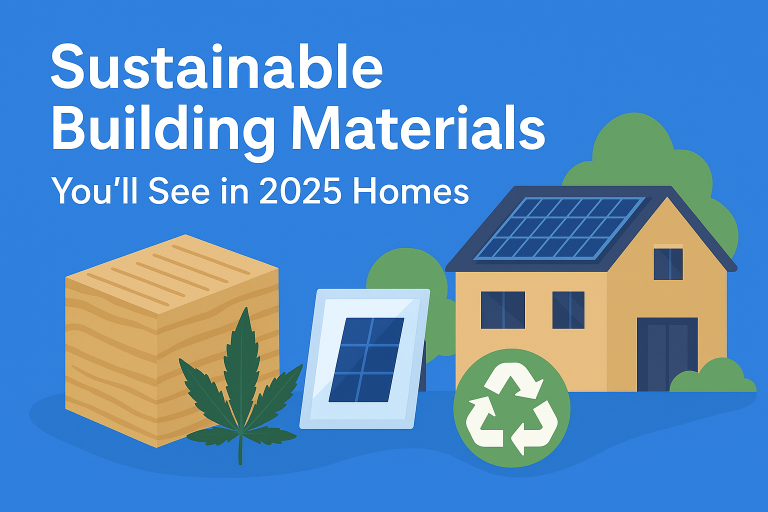Sustainable Building Materials You’ll See in 2025 Homes
In 2025, sustainability will be the main topic of discussion in real estate rather than just location, features, and cost. Building materials that not only lessen their impact on the environment but also enhance the quality of life for inhabitants have gained attention due to the global movement towards eco-friendly living. Both purchasers and developers are now searching for more creative, long-lasting, and ecologically friendly alternatives to the conventional steel and concrete. Let’s look at the materials that are most likely to be used in new homes this year.

Green Materials’ Development
In previous decades, using recycled materials or fly ash in cement was often the only way to achieve sustainability in the construction industry. However, the scope is much broader in 2025. Modern green materials are designed to reduce waste throughout a building’s lifecycle, improve energy efficiency during use, and minimize carbon emissions during manufacturing. Additionally, their ability to survive intense heat, storms, and rainfall is examined in light of climate change.
Leading Materials Revolutionising Building
Timber Cross-Laminated (CLT)
CLT is becoming incredibly popular all across the world. Compared to traditional concrete, this engineered wood product is much more sustainable, lightweight, and incredibly robust. It is a climate-positive option since it locks in carbon instead of releasing it. Hybrid high-rise constructions that combine steel and CLT are increasingly common.
Aluminium and Steel Recycled
Steel has historically required a lot of energy to produce. However, the use of recycled aluminium and steel has become more common since 2025. These materials reduce carbon emissions without sacrificing strength. In order to responsibly obtain steel, many developers in India are increasingly collaborating with recycling facilities.
Composites of Bamboo and Hempcrete
Bamboo and hempcrete are at the forefront of green building because they are natural, renewable, and biodegradable. Hempcrete controls indoor humidity, is lightweight, and provides superior insulation. Bamboo composites are ideal for wall panels, flooring, and even structural applications because of their high tensile strength.
Glass Panels with Solar Integration
Solar glass, a cutting-edge but rapidly expanding option, incorporates photovoltaic cells into windows. Imagine your windows acting as miniature power plants that provide your house with clean electricity. Given the limited rooftop area in metropolitan high-rises, this idea is especially pertinent.
Advantages for Homeowners
Green materials have benefits beyond just being environmentally friendly. For homeowners, they result in real, long-term savings. Lower power costs are a result of improved insulation. Non-toxic materials lower health hazards by improving indoor air quality. Long-lasting composites save upkeep expenses. Because more people are interested in sustainable living, homes constructed with these materials also fetch greater resale values as awareness rises.
Obstacles to Broad Adoption
Making the switch to sustainable materials is not without its difficulties, of course. Construction crews frequently require specialised training, supply chains may be constrained, and upfront costs may be greater. Prices are anticipated to normalise, though, as demand increases and economies of scale take effect. The business is already progressing because to government subsidies, green building certifications, and growing customer preferences.
India’s Contribution to the World Green Wave
Given that India is one of the world’s fastest-urbanizing countries, its real estate decisions are very important. Energy-efficient glass façades, prefabricated CLT panels, and bamboo-based houses are currently being tested by a number of Indian companies. Eco-friendly materials should become more commonplace in the Indian home sector within the next ten years due to increased climate awareness and more stringent building regulations.
The Bottom Line
In real estate, sustainability is becoming the norm rather than an alternative. In 2025 and beyond, homes will increasingly feature materials that are beautiful, long-lasting, and environmentally friendly. Selecting a sustainable home as a buyer or investment offers long-term financial and lifestyle benefits in addition to environmental benefits.
Get in touch with Upgrade Realty
For all of your real estate needs, get in touch with Upgrade Realty, whether you’re thinking about purchasing a house constructed using the newest environmentally friendly materials or would like advice on green-certified projects in Mumbai. Our staff can put you in touch with sustainable innovations, offer thorough cost-benefit analyses, and assist you in making an environmentally responsible and future-ready investment.
